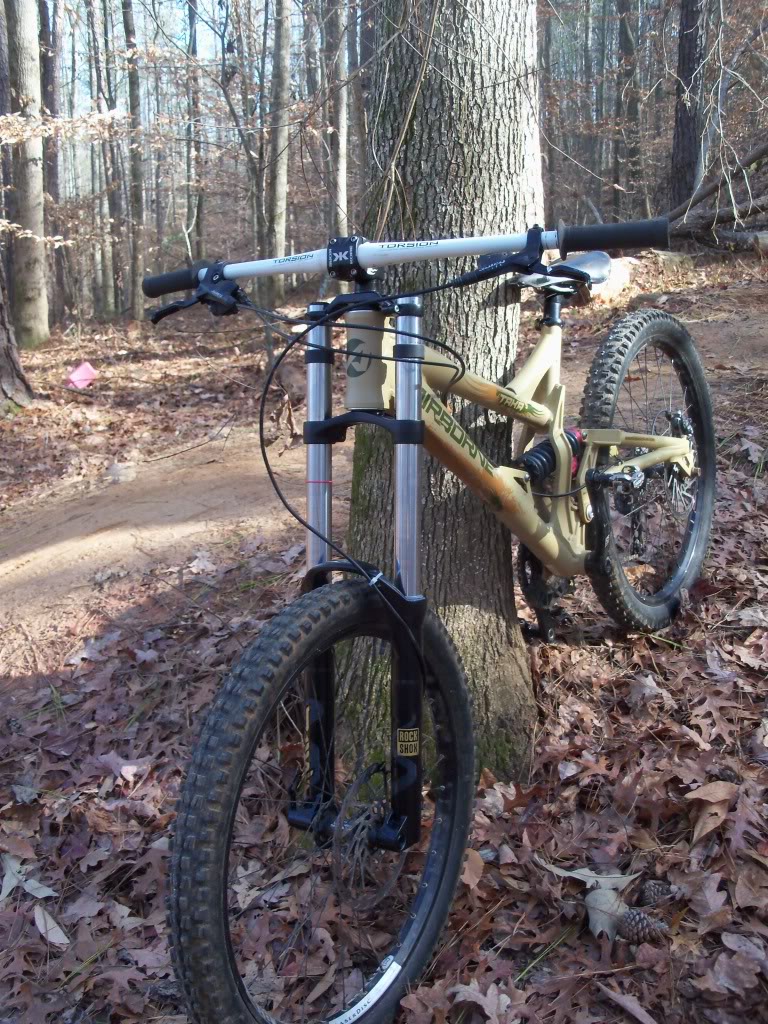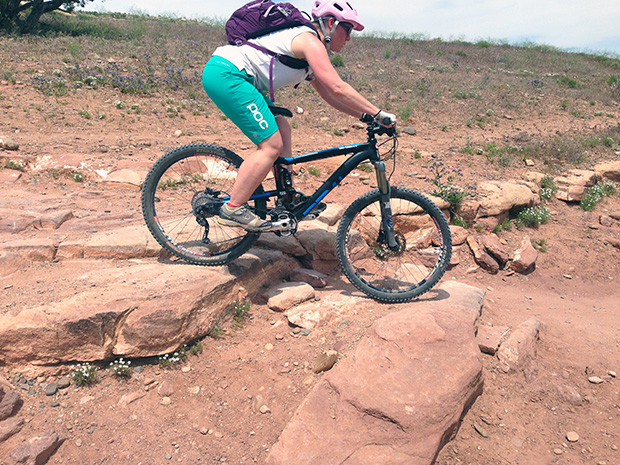Looking for an affordable dual-crown freeride fork for your gravity rig? Look no further than the RockShoxDomain Dual Crown R.
The single-crown Domain R is a long-time favorite fork of freeriders, but RockShox recently decided to offer it in this dual crown configuration as well. While the increase in travel afforded by the bigger fork is one reason, increased durability and longevity is a factor too. Read on for more specifics.
Specs
 The Domain R features a full 200mm (almost 8 inches) of suspension travel for plenty of cushion on those nasty flat drops. A Maxle thru axle and 35mm stanchions keep the front end stiff in the most demanding conditions.
The Domain R features a full 200mm (almost 8 inches) of suspension travel for plenty of cushion on those nasty flat drops. A Maxle thru axle and 35mm stanchions keep the front end stiff in the most demanding conditions.
To keep things simple and costs low, rebound duties are controlled by a spring and oil–there is no air pressure adjustment. However, rebound rate can be adjusted easily with a small hex key and a screw on the bottom of the fork stanchion. To set your sag properly at 30-35%, adjust the spacer stack under the top cap of the left fork leg. To increase fork stiffness and reduce sag, add spacers to the stack. To increase sag, remove a spacer or two.
With an advertised weight of 3,445 grams, this fork is no feather weight–but as a freeride fork it isn’t designed to be. Instead, the purpose of this fork is to take drop after jump after cased landing without complaint, day in and year out.
Contributing to that weight as well as the durability of the fork are the steel stanchions. Steel isn’t the lightest metal to build with, but if you ever lay your bike out in a corner (as you are bound to do once in a while) you don’t have to worry about absolutely destroying your stanchions like you might with a lighter metal.
Installation
I have to confess: I am not a skilled mechanic like element22, and when things get more complicated than a single crown fork with a steerer that’s already been cut and a star nut that’s already been installed, I tend to leave fork installation to the pros. But if you would like to attempt it yourself, be sure to check out this recent post by element22.
Out on the Trail
With a fork as built up like this one, you can imagine how tough it was to feel any sort of complaint from the Domain. From drops to jumps to gnar, the Domain dominated it all! This burly fork is definitely a point-and-shoot affair. Pick a drop, point your rig, and hold on and let it go to town! The predictable rebound and plenty of cush saved my hide on more than one cased jump.
 The visual appeal of this fork cannot go unmentioned. The shiny steel stanchions are a radical departure from the gold-coated aluminum stanchions on many forks, and they definitely stand out in a lift line. The graphics on the lowers are attractive yet not too flashy, and the lowers are available in either white or black (tested).
The visual appeal of this fork cannot go unmentioned. The shiny steel stanchions are a radical departure from the gold-coated aluminum stanchions on many forks, and they definitely stand out in a lift line. The graphics on the lowers are attractive yet not too flashy, and the lowers are available in either white or black (tested).
While not a feather weight, I had no problem controlling the front end and putting it where I wanted it. The massive stanchions, stiff lowers, and stiff Maxle thru axle all helped provide this exceptional control.
One note on the Maxle: with thru axles that are this easy to remove and install, why does anyone bother with bolt-on axles or open drop outs anymore? This lightweight Maxle was an absolute cinch to whip on and off when I had a flat. Honestly, it was faster and easier to install than a standard open drop out quick release axle. When will the mountain bike industry catch on and put thru-axles on everything?
When you look at buying a Domain R, you need to be aware that this is a freeride fork and not a downhill fork. For some people the difference might not matter that much, but for others it is worth being aware of. This freeride fork is designed for jumps and drops, and is perfect for a long day in the bike park. However, if you get it on a downhill course with extended rock gardens, roots, and high-speed chatter, you will realize that this is not a race fork. The fork does not absorb high speed chatter very well, and the initial action on small obstacles can feel a little sticky and stiff at times. However, these are not faults of the fork, as it is not designed to be good at all of these things. But when you get the Domain R on the big hits: then its true colors shine through!
So when you are buying, just be aware: this fork is meant to freeride! And freeride it does–and with plenty of style. With an MSRP of just $660, this is a very affordable dual-crown fork, and offers an incredible bargain for quality performance. If you are in the market, I highly suggest you check out the RockShox Domain Dual Crown R!
Many thanks to RockShox for sending out this fork for review.













1 Comments
Jun 18, 2012